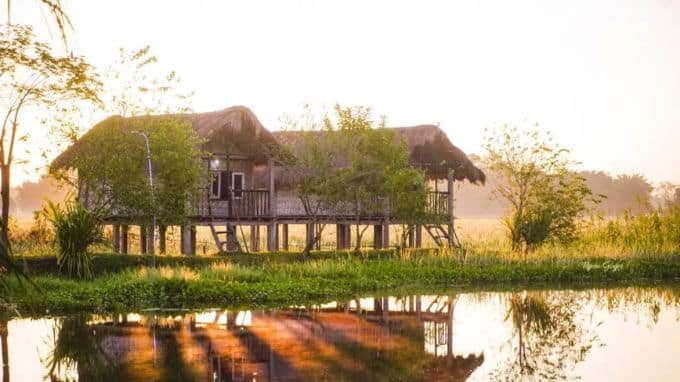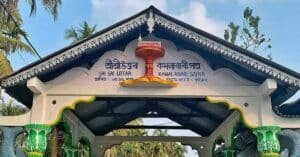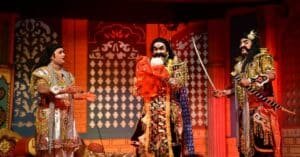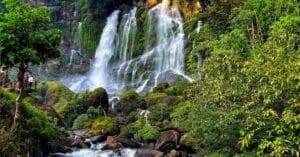Introduction: Majuli Island of Assam
Majuli Island of Assam, is renowned as one of the world’s largest river islands, spanning across an extensive area of 483 square kilometers. Originally, it was a subdivision of the Jorhat district of Assam, but in September 8, 2016, it was granted separate district status, with its headquarters situated in Gormur.
According to the 2011 census, the island (Majuli district) has 194 villages with a population of over 1 lakh 56 thousand and a density of 300 individual per Square Kilometer. The people of Majuli island of Assam mainly speak Assamese and Mising/Mishing language. Unfortunately, the island has experienced significant land loss, with over 500 square kilometers of its territory eroded by the relentless waters of the Brahmaputra.
Where is Majuli Island located?
As a riverine island, Majuli is situated within the waters of the Brahmaputra River. To the north of Majuli, you’ll find the Lakhimpur district of Assam, while to the south of Majuli, you’ll discover the Jorhat district of Assam.
People of Majuli
It is primarily a rural district, with a total population of 1,67,304 out of which 46.38% and 14.27% belongs to Schedule Tribe and Scheduled Caste respectively as per Caste Census 2011. The people of Majuli island can be grouped as follows: 1. Monks of the Satra: They are Assamese Vaishnavite3 monastic community in the Satras. They believe in the Eksarana Dharma propagated since 16th century . 2. Sonowal Kacharis: The gold craftsmen to the Ahom Kings and followers of Mahapurusha Vaishnav Dharma. However, many have retained their sacrificial customs which predates their conversion to Vaisnavism. 3. Deoris: An Indo- Mongoloid race of Tibeto-Burman linguistic group and the erstwhile priests of the ruling Chutiya lineage and believers of primordial power. 4. The Mising: A tribe of Tibeto-Burmese origin.
There are Brahmins, Kalitas, Misings, Nath, Kochas, Chutias, Ahom, Kaibartas, Mattaks, SonowalKacharies, Nepales and Bengalies in Majuli living since time immemorial.
How to Reach Majuli Island of Assam?
Majuli enjoys good connectivity with the Jorhat and Lakhimpur districts of Assam, offering several transportation options for visitors:
By Ferry from Jorhat: Jorhat serves as the nearest road connection to Majuli. ASTC buses operate within the state on a daily basis, and there are both day and night deluxe buses plying the route from Guwahati to Jorhat every seven hours. To reach Majuli Island from Jorhat town, you must board a ferry. The nearest port is Nimatighat in Jorhat district, and it takes approximately 1 hour to reach Majuli from Nimatighat. Ferry services are available from 7 am to 3.30 pm.
By Road from Lakhimpur: You can also reach Majuli from the Lakhimpur district by road, passing through Dhakuakhana.
By Train: Majuli does not have its own railway stations. To access Majuli by train, travelers must take a train from Guwahati to reach Jorhat, which is the nearest railway station to Majuli. From Jorhat, buses and taxis are available to transport tourists to Neemati Ghat, where ferries provide passage to Majuli.
By Air: Flights to Jorhat are frequent from Guwahati and other parts of the country, with four weekly flights from Kolkata to Jorhat as well. Upon arriving in Jorhat, private cabs can transport tourists to Neemati Ghat. Alternatively, visitors can book a taxi from Jorhat and take it on the ferry to Majuli. There is also Lilabari Airport in North Lakhimpur, from which Majuli can be reached via Dhakuakhana.
Landscape of the Majuli Island of Assam
The landscape of Majuli Island is characterized by its unique fluvial nature, situated as a riverine delta. It rests at an elevation of approximately 85 to 90 meters above mean sea level and is encircled by a network of rivers and their tributaries, including the Subansiri River, resulting in extensive wetlands. Another notable aspect of this geographical system is the formation of smaller islets, locally known as Chaporis, in the vicinity of Majuli. This formation is a consequence of the river’s braiding. In the waters surrounding the island, there are 22 such Chor-Chapar islets. About 25.85 percent of Majuli’s total land area is suitable for cultivation, and although the cultivable land is relatively limited in size compared to the island’s total area, it is characterized by its fertility and suitability for various crop production.
How Majuli Island was formed?
Majuli Island’s formation is a product of significant geological events. Originally, it was a long, slender piece of land called Majoli, situated between the Brahmaputra River in the north and the Burhidihing River in the south, where they met at Lakhu. A series of frequent earthquakes between 1661 and 1696 set the stage for a catastrophic flood in 1750, which lasted for 15 days. This massive flood altered the course of the Brahmaputra, diverting part of its flow southward into what was once the lower channel of the Burhidihing. Consequently, Majuli Island came into existence.
This dramatic shift also led to the reconfiguration of the river channels in the region, with the Burhidihing’s point of confluence moving 190 kilometers to the east, while the northern channel of the Brahmaputra became the Luit Xuti, later known as the Kerkota Xuti. The Burhi Xuti, the southern channel, expanded through erosion and eventually became the main Brahmaputra River.
Brief History of Majuli Island of Assam
Majuli, once known as Ratnapur and capital of the Sutiya kingdom, holds a rich history. The Ahom king Pratap Singha fortified it with Meragarh. During the Moamaria rebellion, it was controlled by Haoha. Majuli became the cultural heart of Assamese civilization from the 16th century with Srimanta Sankardeva’s visit. He pioneered the neo-Vaishnavite movement, promoting monotheistic Vaishnavism, and established satras, making the island a Vaishnavite hub. British rule continued until India’s independence in 1947.
Festivals and Celebrations of Majuli Island of Assam
Ali aye ligang: Ali-Aye-Ligang or Ali-Ai-Ligang a spring festivity associated with agriculture, celebrated by the Mising or Mishing tribal people of Assam. It is on the occasion of the beginning of the Ahu paddy cultivation.The festival marks onset of sowing seeds.The name of the festival is made up of three terms, ‘Ali’, legumes, ‘Aye’, seed and ‘Ligang’, to sow. The festival begins on the first Wednesday of the Phalguna (ফাগুন),the 12th month of the Hindu calendar. It falls on the English month of February.
Raas Mahotsav : Raas Mahotsav (festival) held in Majuli during November, is a vibrant celebration of the life events of Sri Krishna, a revered Hindu deity. This festival features colorful performances, including dances, plays, and the traditional art form of Ankiya Bhaona, which vividly portrays the life events of Krishna and various other mythological stories.
Ankiya Bhaona : Majuli Island has long held a prominent cultural position in Assam, dating back to the medieval period. The influence of the bhakti movement and the cultural contributions of luminaries like Srimanta Sankardev and Madhavdeva have left an indelible mark on Majuli. Celebrated alongside the Raas Mahotsav in the month of November, the tradition of Bhaona, a form of traditional theater, is a significant cultural attraction. Sometimes, standalone Bhaona performances are organized to meet specific demands and mark special occasions. This rich and vibrant tradition continues to draw people from across Assam to Majuli, making it a cultural and artistic center of the region.
Read this blog to know more about raas mahotsav, bhaona and mask making (Mukha Shilpa)
Bihu : Similar to other parts of Assam, Bihu, a cherished Assamese festival, is celebrated with great enthusiasm on Majuli Island. One of the most prominent Bihu festivals, known as Bohag Bihu, is observed during the spring season, typically in April. This festival marks the onset of the Assamese New Year and is characterized by colorful cultural events, traditional dances, and vibrant festivities that capture the spirit of renewal and the joys of spring.
Majuli Music Festival: Since its inception in 2019, the Majuli Music Festival has become a significant cultural event on the island, aimed at showcasing the vibrant cultures of Majuli and drawing in tourists. This annual festival, held in November, coincides with the Raas Mahotsav, offering a diverse range of musical performances and cultural displays that capture the essence of the island’s heritage. Through music, the festival seeks to celebrate the rich traditions and artistic expressions that have made Majuli a unique and alluring destination for visitors from all around. Read this blog to know more about Majuli Music Festival.
Tourist attractions and activities
- Visit Various Vaishnava Satras (Monasteries) founded by Sankardeva.
- Celebrate the Raas Mahotsav in Majuli during November
- Visit during Paal Naam and Ali-Aye-Ligang festival
- Explore the colourful culture of the tribes
- Explore the Mask Making
- Explore Pottery Making culture in Majuli
Pilgrimage and Culture Tour
A multitude of travelers visit Majuli Island of Assam primarily for pilgrimage and cultural exploration. The island boasts a total of 22 Satras, each offering a captivating representation of Assamese culture and traditions. While it may not be possible to visit all of them, you can certainly explore a selection. Satras serve as Vaishnavite institutional centers where various activities like theatrical performances, prayers, and knowledge dissemination take place. Some of Majuli Island’s oldest Satras have origins dating back to the 17th century. Among these, Chamaguir stands out as a prominent choice for a visit. Here, you can witness the craft of crafting traditional masks inspired by characters from the Ramayana and Mahabharata.
Birdwatching and Nature experiences in Majuli
Majuli is a veritable paradise for birdwatching enthusiasts, thanks to its diverse wetlands and forested areas that beckon a wide array of avian species. Its proximity to the Brahmaputra River and the presence of untouched natural vegetation make it a magnet for these winged visitors. The island is home to numerous locals and migratory birds that can be seen during the winter time. Some feather creatures that you can expect to see are storks, pelicans, whistling teals and Siberian cranes. Nature walks are also a prominent activity here, allowing visitors to stroll along the picturesque riverine sandbars and revel in the majestic beauty of the Brahmaputra River, all while immersing themselves in the island’s pristine and captivating wilderness.
Accommodation Facilities: Where to stay in Majuli
Majuli Island of Assam offers a distinctive accommodation experience with its iconic bamboo cottages adorned with thatched roofs, equipped with modern amenities to ensure a comfortable stay. Local businesses have played a significant role in developing and promoting these traditional yet cozy cottages, which are a unique hallmark of the island. Additionally, for those seeking more conventional lodging, there are resorts and hotels, including 3-star and lower-rated options, conveniently located near the island’s major tourist attractions, providing a range of choices to suit various preferences and budgets.
Best Time to Visit Majuli Island of Assam
The ideal time to visit Majuli Island of Assam is during the autumn and winter seasons, which span from November to March. This period offers pleasant weather (average temperature between 10 to 22 degree) and is the most favorable for exploration. Majuli experiences hot and humid summers, making them less comfortable for travel. It is advisable to avoid the monsoon season, which occurs from May to October, due to heavy rainfall and potential flooding. Furthermore, visiting during the autumn and winter months allows travelers to immerse themselves in the island’s vibrant festival scene, as many cultural events and celebrations take place during this time, providing a unique and enriching experience for visitors.







